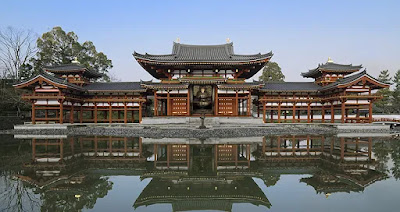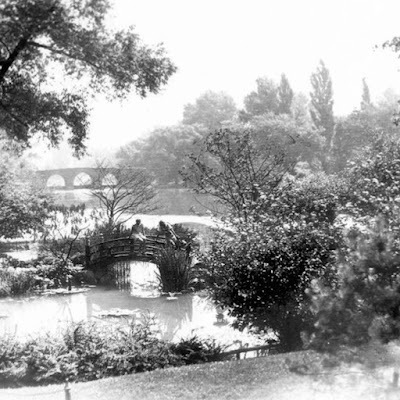History
A Gift from the Emperor of Japan
On February 24, 1890, after Chicago was selected to be the site of the World’s Fair, the President of the United States invited the nations of the world to participate in the Fair. Nations could participate by competing for space in the themed buildings (Horticulture, Agriculture, Electricity, Mines and Mining, Transportation, Machinery, Manufacturing and Liberal Arts, Women’s, Fisheries, Forestry, Leather Goods, Anthropology, Palace of Fine Arts) and by building a separate national pavilion.
Japan, which had just emerged from its long isolation, used the themed pavilions to advertise its technological and industrial prowess. It was one of the few nations that successfully won space in all the themed buildings. In addition, it set up a store on the Midway Plaisance (where commercial enterprise was allowed), provided a tea house for refreshments near the Marine Cafe, and built a national pavilion. For a detailed look at Japanese participation in the Fair, see Room 2: At the Fair | bucsa-asiaworldsfair (asiaworldsfairs.org)
 |
Most of the national pavilions were southeast of the Palace of Fine Arts (now the Museum of Science and Industry) and most housed offices and apartments for visiting officials and provided small exhibits for the public.
The Japanese pavilion, however, was a permanent gift to Chicago. It was a gift from the Emperor designed to introduce the United States and the world to the history and architecture of Japan. It was across the bridge from where the other national pavilions on Wooded Island. Everyone wanted to get their building on Wooded Island because it was central to the lagoon area, but the design called for no buildings on the restful natural area. The Japanese convinced Olmsted and Burnham that the pavilion would enhance the purpose and, since Wooded Island was the only original and permanent ground in the park, the permanent gift belonged there.
The Japanese used a profoundly important temple as inspiration: The Hōōdō temple—the Phoenix Temple—built in 1052 and was the model for the pavilion. The Phoenix comes down from heaven at the start of a new era to bring peace and prosperity, which was the goal the Japanese had at the Fair. It was also of course a nod to Chicago rising from the ashes of the fire of 1871--the Western concept of the phoenix.
 |
| The Hōōdō temple—the Phoenix Temple—built in 1052 |
A theme of the fair was the sweep of history, so the Japanese pavilion was designed to show the sweep of Japanese cultural history. It had two wings and a center space. The north wing represented the Fujiwara Period from 980-1185 c.e., the south wing represented the Ashikaga Period 1333-1568, the center represented the Tokugawa Period 1615-1867 and was the most ornate.
Architectural Significance
The pavilion was built in Japan, using the traditional methods of no nails. It was disassembled and shipped to Chicago, arriving in December 1892 along with 24 Japanese workmen, who reassembled it on the island.
 |
| Constructing_Japanese_Pavilion_Ho-o-den_03_at_World's_Columbian_Exposition,_Chicago,_1893.jpg |
Chicagoans were fascinated. The Fair had to do crowd control during construction by charging 25 cents a day ($7 in 2021) to watch. One of the Chicagoans was Frank Lloyd Wright, who was working on the Transportation Building. He was fascinated by the low over-hanging eaves, the horizontal lines, the open interior, the use of natural materials, the movable screen walls, and the relationship with the environment. The Ho-o-Den revolutionized domestic architecture through the Prairie School of architecture.
First Revival
After the fair, the pavilion stayed on Wooded Island through the following decades, somewhat neglected. The Chicago Park District decided to revive the area in the 1930s. The Palace of Fine Arts was reconstructed with limestone to become the Museum of Science and Industry, WPA workmen created new gardens throughout the park, and the Japanese pavilion was restored.
A Japanese stroll garden was added. Taro Otsuka, an issei garden builder, based it on the 1894 design by George K. Shimoda. The tea house from the 1933 World’s Fair was brought to the garden and the area was gated and protected.
This garden had a somewhat different design from today. There was a small double pond, a moon bridge in a different location, and the walkways were ornate.
The Park District hired Shoji Osato and his family to operate the complex. Osato was a first generation Japanese photographer who had married an Irish-American woman from Kansas. They hired from the local Japanese community to work in the complex and introduce Westerners to Japanese culture.
 |
| Cushman Collection |
In 1941, the Japanese bombed Pearl Harbor. Though Chicago was outside the Western exclusion zone, Shoji Osato was incarcerated. Not only was he still a Japanese citizen--because it was illegal for first generation Japanese to become U.S. citizens--but he was a Japanese citizen celebrating Japanese culture by operating the Ho-o-Den and the tea house. His family divided up—one daughter was renowned ballet dancer Sono Osato already in New York, one son fought in the highly decorated WWII unit, the 442nd regimental combat team, made up of second generation Japanese-Americans, many of whom had been recruited from the internment camps.
 |
| Shoji Osato with Sono Osato Media — Sono Osato Film |
The structures of the Ho-o-Den and the tea house were left unprotected and were eventually destroyed by arson in 1946.
After the war, Shoji Osato died soon after he was released from the internment camp. Wooded Island itself was neglected because the north end of Jackson Park had become a Nike missile base. The area was not open to the public.
Second Revival
In 1971, with the base gone, Chicago once more turned its attention to Wooded Island. The Japanese Garden was recognizable only by the stepping stones, lantern, and water lilies in the lagoon. You can still see the stepping stones that rise to the current structure in the garden.
 |
| Stepping stones in 1935 Chicago Park District photos |
A neighborhood organization, the Hyde Park/Kenwood Community Conference, began holding a series of annual Wooded Island festivals to draw attention to the area. The organization cared, among other causes, about landscape beautification, parks, and gardening.
 |
| UChicago photographic archive apf7-04610r.jpg |
Through the efforts of its neighbors, in 1974, Jackson Park was put on the National Registry of Historic Places and in 1977 Wooded Island was declared the Paul Douglas Nature Sanctuary to protect the 250 species of birds that migrate through and live on the island, thanks to the efforts of Doug Anderson, long-enduring Audubon volunteer and neighborhood resident.
In the 1970s, a determined planner, George Cooley, pressed forward with plans for the Japanese Garden restoration. In 1981, there was a garden once more with the current open pavilion, a moon bridge, paths marked with wooden lanterns, and a small waterfall. The design was by Kaneji Domoto, who himself had been interned in World War II and had studied with Frank Lloyd Wright at Taliesin, so the restoration was deeply personal. George Cooley and Kaneji Domoto received the Frederick Law Olmsted Award in 1983 for their long fight to once more have a Japanese Garden.
In the 1980s, the garden struggled with vandalism and neglect. Few people visited. The moon bridge was destroyed, dismantled with crowbars. It may have been a target of auto workers in the 1980s, who thought Japanese automobile manufacturers were taking their jobs.
Third Revival
In 1993, Osaka, Chicago’s sister city, recognizing the significance of the long Japanese presence on Wooded Island, restored the garden with a major redesign by Kenichi Miyazaki, Osaka’s park director. Osaka also donated the splendid gate by Koichi Kobayashi. At that time, there were a series of annual Osaka Garden festivals, but on too many days, it was empty and unattended. Vandalism continued and lanterns and koi were stolen.
In 2002, there was a major rehab of the lagoon side to protect the garden from the fluctuating levels of Lake Michigan. Steel retaining walls line the edge of the pond and 120 tons of rock were reset. Sadafumi Uchiyama designed the changes, including changing the waterfall from a weak 80 gallons per minute to 600 gallons per minute to bring real music to the garden.
In 2011, The Garden of the Phoenix Foundation discovered that the ranma panels that once hung in the 1893 pavilion still existed. They had been rescued after the arson and hidden in storage, forgotten. They were carved by renowned artist Koun Takamura. Money was raised for their restoration and the panels are now on display in the Art Institute of Chicago. Transom panels (ramma) from the Phoenix Pavilion (Hooden) | The Art Institute of Chicago (artic.edu) They give a sense of how rich the gift from the emperor was to the city of Chicago.
In 2013, the Project 120 Foundation organized a commemoration of the Fair and the history of Japanese and American relationships by planting 120 cherry trees around the Columbian Basin south of the Museum of Science and Industry. In Japan, eras of life are marked in 60 year cycles, so 120 years was an auspicious anniversary. The next year 50 more trees were added to commemorate 50 years of the Japanese Chamber of Commerce in Chicago.
In 2015, having heard the story of the Garden of the Phoenix, Yoko Ono began work on SkyLanding, to heal the site of the original Ho-o-Den Pavilion and anchor the wish for world peace at the site where the world once gathered. Yoko Ono as a child had experienced the fire-bombing of Tokyo. It is the North American installation of her project to anchor peace around the world. It brings together the phoenix’s gift of peace and prosperity and the unifying power of the sky.
Also in 2015, three fusuma (painted sliding doors) believed to be by Hashimoto Gaho were discovered in Park District storage by historian Julia Bachrach. Fusuma are representative of traditional Japanese construction techniques. The inner wooden fretwork was covered with a layer of paper before the painted surfaces were attached. Before installation, the black lacquer frames were fitted over the edges of the fretwork cores. The frames were then eased into waxed grooves in building’s floor, where the paintings functioned as sliding door. Hopefully, these too can be restored.
In 2018 and 2019, experts from Japan came to advise the park district on maintenance. At that time they worked to redo the stones of the waterfall, making it the more complex cascade it is today. They also provided a template for expansion and redefinition of the garden.










